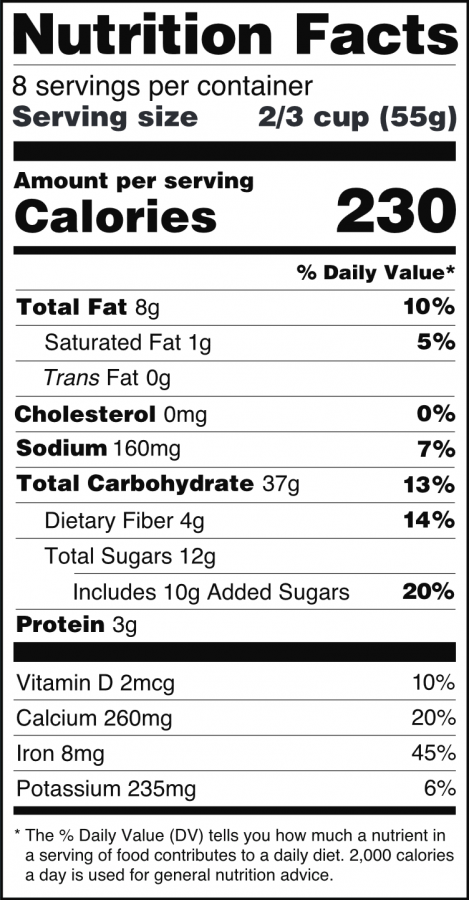The FDA completely spoils food labels?
Nov 1, 2017
Back in May 2016, the Food and Drug Association (FDA) renovated the more than 20 year old Nutrition Facts Label. While the label has been public information for well over a year now, foods with this updated information are finally hitting the shelves – along with strong reactions from consumers.
The changes that the FDA has issued include:
- Number of servings in each item will be in a bolder font
- Updated, more modern, serving sizes
- The number of calories has been bolded and put in a much bigger font
- Daily values have been updated
- “Added sugars” value has been added
- Nutrient value has been updated
- Actual amount of nutrients and vitamins are declared either in micrograms or milligrams
- A new footnote
The FDA hopes that these improvements to the label will help the general public make more informed decisions when choosing what food to eat, but will it really do that?
Promising Practicality for Parents
From one perspective, the updated labels provide parents with more information to make decisions for their children. Because added sugar is defined by the FDA as “sugars that are either added during the processing of foods, […] sugars from syrups and honey, and sugars from concentrated fruit or vegetable juices that are in excess of what would be expected from the same volume of 100 percent fruit or vegetable juice of the same type,” parents will essentially have a better understanding of how processed their kid’s food is.
Another addition aimed to aid parents, but which can really help anyone, is the elimination of the requirement that companies to list the amounts of Vitamins A and C, and the addition of mandatory listings of Vitamin D and potassium. According to the CDC, most of the population in the 1990s was lacking in Vitamin A and C; now deficiencies in these nutrients are a rare occurrence. On the other hand, more people are lacking Vitamin D and the proper amount of potassium in their diets. The labels are changing to reflect the population.
In addition to new nutrients being shown, % Daily Values have been updated and now more accurately reflect the 2015-2020 Dietary Guidelines for Americans. These new numbers will help people track how much of which nutrients and minerals they are ingesting, and which ones they need to focus on getting.
The changes made to the Nutrition Facts Label seem like they will make a helpful difference in people’s lives. They are more accurate by today’s standards, they hold relevant information, and they now hold more information. What’s not to like about it?
Counting Calories
While the FDA hoped to make people’s lives easier with the new label, they may have caused more problems.
Since the calories are now in a bolder, and much larger, type, your attention is immediately going to be drawn to them. But why is that bad? you might ask; shouldn’t we all be more conscious of how many calories we consume? We should be conscious of what we’re putting in our bodies, but the focus should be shifted from how many calories we eat to what we eat. By emphasizing the number of calories, we learn that as long as we meet this special number, we’ll be healthy and fine. In reality, however, there is more to nutrition and eating than the number of calories; true nutrition and wellness is about finding a balance that works for your specific body type and level of activity.
Another aspect to consider is the possibility that the new focus on calories may upset people who are recovering from eating disorders or disordered eating; this is caused by the implied importance that comes with the larger, bolder calories. Along with making a better connection with food and coping with underlying problems, focusing less on your caloric intake and more on nutritional intake is a fundamental step in recovering from eating disorders, and this change to the label makes the calories harder to ignore. The FDA is trying to get more people to think about their daily calories, but it makes the person recovering from an eating disorder feel more guilty about eating that food. They are hyper-aware of how many calories they are consuming. The new labels could set people back in their progress toward healthier habits and beliefs about food.
The Food and Drug Association made these changes with the idea that people will use them make better choices, but they might have unknowingly caused a large group of people to backtrack on their road to recovery. These changes also promote the idea that calories are the only thing that’s important about food, and the majority of people know this is not true.
So what’s the verdict?
The new Nutrition Facts label is something that I believe can be useful. Like many other things in life, it is a tool, and if you don’t know how to use it, you won’t get much from it. I think that with more education about eating right and how to recognize when eating is not healthy, the new label will be even more helpful and relevant in our daily lives than it already is. Personally, I don’t like the change in the font sizes, but it’s nice to know that the % Daily values have been updated for this century.










